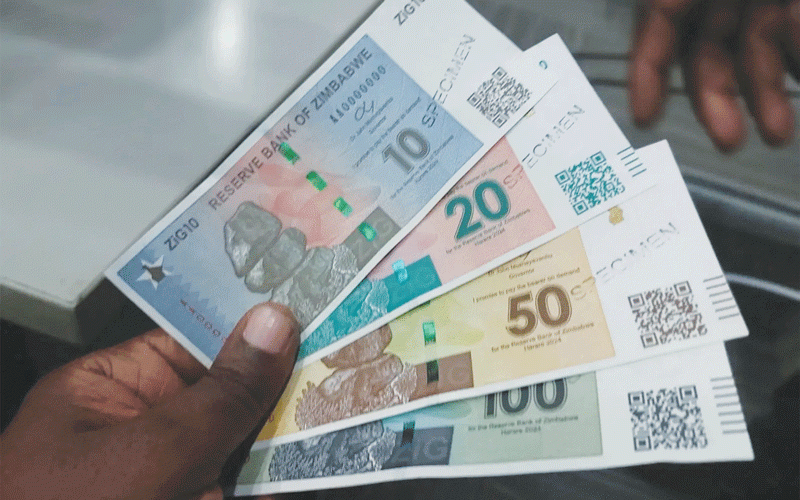
On 5 April, 2024, Zimbabwe introduced the Zimbabwe Gold (ZiG) as a bold step towards stabilising its economy and creating confidence in its currency regime.
In an economy that has gone through successive periods of currency failures, now, a year on, the question of paramount importance is: has ZiG performed any better than its predecessors?
This article explores the successes and challenges of ZiG over the past year, examining its impact on inflation, foreign exchange stability, and public trust.
Unlike its predecessors, ZiG is backed by gold and other precious minerals, which lends it a degree of credibility that the Zimbabwe Dollar (ZWL) and Bond notes lacked.
Though the Bond note was backed by US$200 million from African Export-Import Bank, the intrinsic value of gold and precious metals provides a more stable foundation, reassuring investors and consumers alike. This backing not only helps to mitigate inflationary pressures but also fosters trust in the currency, as gold has historically been viewed as a reliable store of value.
A year after its launch, ZiG, which replaced the ZWL at a rate of 1ZiG:ZWL2 500, presents a mixed picture of performance marked by both initial optimism and ongoing structural economic challenges. Initially, the introduction of ZiG helped reduce month-on-month inflation, dropping from over 55% during the ZWL era to single-digits in the first few months of circulation.
However, inflation spiked dramatically in October at 37,2%. Nevertheless, a notable decrease in inflation was observed from December onwards, culminating in a deflation of -0,1% in March. This trend suggests that while ZiG may have encountered some turbulence, it has begun to stabilise, leading to improved economic conditions.
The movement from high inflation to near zero rates indicates that ZiG’s backing by gold and other precious metals may be contributing to restoring confidence in the currency, though sustained efforts are needed to maintain this positive trajectory.
- Japan brings cheer to Gokwe
- Commodity price boom buoys GB
- 9 000 farmer field schools on cards
- Biti’s applications for referral to Concourt continues
Keep Reading
Nonetheless, while price volatility initially dropped, there have been reports of price dualisation with some retailers preferring the US dollar, and causing instability in pricing structures.
Focusing on the exchange rate, the exchange rate of ZiG to the US dollar started at US$1:ZiG13.
It has displayed considerable volatility. By September 2024, just five months after launch, the rate had surged to US$1:ZiG24,8831, indicating a sharp depreciation of ZiG.
Despite a slight improvement in the following months, the exchange rate has remained elevated, peaking at US$1:ZiG28,6802 in October before stabilising around the US$1:ZiG25 to US$1:ZiG27 ranges from November 2024 through March 2025.
As of April 11, 2025, the exchange rate stood at US$1:ZiG26,8103, suggesting that while there has been some degree of stabilisation, it is still far from the initial value.
Overall, ZiG has not managed to achieve true exchange rate stability over this period. The initial fluctuations reflect ongoing economic challenges and market adjustments following its introduction.
Although the rate has shown some signs of stabilisation, the significant depreciation early on raises concerns about the currency's resilience and the broader economic environment in Zimbabwe. Continued efforts will be crucial to enhance confidence in ZiG and achieve a more stable exchange rate moving forward.
Due to a surge in exchange rate pressures, a widening gap between official and unofficial exchange rates, increasing inflationary pressures, and market dynamics, the Reserve Bank of Zimbabwe devalued ZiG by 43% on 27 September 2024, causing a 43% decrease in the official exchange rate from US$1:ZiG13,9 to US$1:ZiG24,4.
The strain on ZiG has intensified, with speculation that it will continue to weaken, potentially causing upward pressure on import prices, reigniting inflation, increasing business costs, and deterring foreign investors.
Overall, while ZiG has shown some capability in controlling inflation, its overall performance in achieving exchange rate stability and gaining public confidence has been inadequate.
While the success in curbing inflation is largely attributed to the RBZ’s tight monetary policy, the persistent shortages of local currency may suggest that the country is operating under an acute inflation-targeting mode that may risk stifling economic growth and may hinder the attainment of the projected 6% growth rate for the year.
The significant depreciation and ongoing volatility underscore the need for continued efforts and policy adjustments to enhance confidence, stabilise the currency, and ensure sustainable economic growth in Zimbabwe.
Going forward, the mixed performance of ZiG after its first year indicates both progress and scope for further improvement. While the RBZ’s tight monetary policy has been effective in curbing inflation, at times even resulting in deflationary trends, there may now be scope for a cautious loosening of this stance.
Such an approach could allow for continued inflation control without unduly constraining economic growth. To reinforce public confidence in the local currency, it is recommended that the central bank adopts gradual and predictable policy adjustments, avoiding abrupt changes in interest rates or liquidity conditions.
Additionally, the use of forward guidance should be prioritised as a tool to manage market expectations and enhance policy credibility effectively. Public trust in the currency can also be strengthened through greater transparency, particularly regarding the level of gold reserves held by the Reserve Bank of Zimbabwe.
Clear and consistent communication on these reserves will contribute to building confidence in the backing and stability of ZiG. It must be acknowledged that inflation control and currency stability cannot be achieved solely through the efforts of the central bank.
To establish a robust productive capacity that can support and anchor a stable currency, initiatives such as the RBZ’s Targeted Finance Facility should be complemented by broader, economy-wide productivity policies.
These include promoting mineral and agricultural beneficiation, intensifying the formalisation drive, and implementing comprehensive economic reforms aimed at strengthening governance, enhancing transparency, and ensuring fiscal responsibility.
Furthermore, efforts should be directed toward diversifying the economy to reduce overreliance on gold and other singular commodities. Strategic investment in key sectors such as agriculture and manufacturing is essential to foster long-term, inclusive, and sustainable economic growth.
Mavodyo is an economist and researcher with experience in consultancy and a strong focus on economic policy analysis and advisory. He is a senior lecturer at the University of Zimbabwe, Department of Economics and Development. — emavodyo@bmse.uz.ac.zw.






